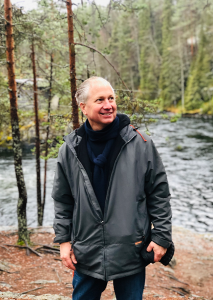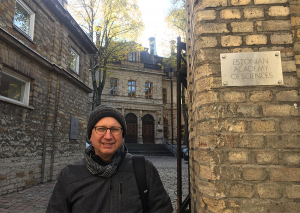Matador Finds New, Creative Ways to Teach Music in the U.S.

Photo courtesy of Richard Frank.
After two decades as both a professional jazz musician and Hollywood business executive, Richard Frank discovered a new way to apply his skills.
In 2016, while giving a music clinic in a Palo Alto private high school, a confident Frank stood in front of the class and asked the students, “How can we start this song differently?”
One boy’s hand shot up. “You can’t start the song differently,” the boy countered. “You have to start it the way it was on the recording, the way the sheet music is.”
That didn’t really answer the question, so Frank asked another: “Why’s that?”
The classroom went silent, but only for a moment. Soon, the class started to erupt with questions and comments:
“Why don’t we do this?”
“We can do that!”
Frank let the students get to work. Within five minutes, the group had drafted an entirely new arrangement for the song.
Since 2013, Frank, who graduated in December with a master’s in educational technology from CSUN’s Michael D. Eisner College of Education, has been developing a grassroots music education initiative for secondary school ensembles called PlayTheGroove — which introduces new ways of learning, to make music more accessible for American teenagers. The program is a modern music education curriculum designed for secondary school students that emphasizes ownership, inclusivity, individualism and creativity. It integrates and encourages music skills such as sight-reading, playing by ear and experimenting with creative musical expression.
“One of the key things is that students get to take ownership of their learning. They have more of a say in what they like to do,” Frank said. “A lot of systems don’t provide choice — they’re told what to do a lot of the time in the music world.” His encounter with the initial reticence of the Palo Alto high school class reflected that status quo, as well as how successful and creative music students could be when they’re given more liberty in the classroom, he said.
A Groovy Library
PlayTheGroove offers a library of no-cost sheet music and original recordings of contemporary jazz tracks, accessible anytime and anywhere through a web-based platform, from which students can select the songs they’d like to play in their music classes. (The site will eventually charge for this service.) After selecting the songs, students can collaborate and creatively decide how to rehearse and play those pieces. In exchange for the complimentary methodology and content, teachers participate in Frank’s ongoing research study.
The concept originated in 2009 when Chris Stevens, a music teacher at Long Beach Polytechnic High School, said to Frank that he’d love to teach in his own classroom more current songs from CDs and recordings by Frank’s groove jazz band, Present Tense. Soon, with the help of Stevens as a lead advisor, Frank started developing the program.
In 2013, Frank developed the first version of PlayTheGroove and launched its website later that year. He realized he needed more research and evidence to avoid sounding like a salesman, or a fraud — perhaps a bit like Broadway’s iconic “Music Man,” Harold Hill.
He started the process by taking graduate courses at USC in 2014, and transferred to CSUN to study educational technology in spring 2018.
“I started researching,” he said, “and Finland kept coming up over and over and over when I was reading about innovative music ideas.”
The Finnish Way
Last year, with the support of his advisors at CSUN, Frank jumped on an opportunity to conduct research overseas to find the best way to execute his plan.
From Sept. 27 to Dec. 2, 2019, Frank participated in a music education residency at the Sibelius Academy of the University of the Arts in Helsinki, Finland. There, he closely observed the Finnish system of teaching rhythm-based music in secondary schools, which aligns with the concepts that drive PlayTheGroove. As Frank would discover, choice and experimentation — the key concepts explored in PlayTheGroove — are pillars of creative music making and an approach embraced by the Finnish music education system.
Contemporary Finnish researcher Heidi Partti found that musiikin luova tuottaminen kouluissa, or “creative music making in schools” in Finnish, generates new knowledge about music and innovative forms of composition through the use of technology and other tools and skills.
A major difference between the Finnish and U.S. music education systems, Frank said, is who’s steering the learning process.
“A lot of times [in the U.S.], the teacher would tell [students] how to play a song, by conducting and breaking it down and doing all the work for them,” he said. “But in creative music making, students get more choice in what they want to play how they want to play it — who starts, how they want to arrange it, whether or not they want to improvise.”
Frank contacted the authors of the Finnish research papers he found on creative music making, asking them questions about how music was taught in the country. Later, after learning more about Frank’s initiative, they invited him to see it for himself.
Choose Your Own Musical Adventure

Photo courtesy of Richard Frank
During his residency at the University of the Arts in Helsinki, Frank met the researchers with whom he’d corresponded, as well as observed four music high schools and supplemental music programs in Finland.
Despite finding that jazz was not as popular in Finland, which teaches mostly pop music, Frank said, what he saw underneath was nearly identical to PlayTheGroove. In Finnish classrooms, students choose their own music, and the teachers guide them in what they want to learn. The students largely direct themselves, taking an active role in their learning, Frank said.
Additionally, Frank found that Finland’s music education system is driven by rote teaching (memorization by repetition) and playing by ear, whereas in the U.S., reading sheet music is largely the norm. This was a significant difference that was not exposed in the research Frank read previously, he said, but something he observed during his visits.
Another standout feature of the Finnish system, Frank said, is that teachers are required to have a master’s degree — which, for music educators, involves gaining some mastery in all basic instruments of the rhythm section — in order to teach, even in elementary and secondary schools. These expectations for educators elevate the teaching quality for children, even from a young age, he said.
The experience in Finland enriched his research, Frank said.
“It’s important to visit countries to directly meet with the people there, and not take what you read at face value,” he said.
In December, working remotely throughout his residency abroad, Frank completed his final core courses in CSUN’s educational technology program, achieving his master’s degree. He completed his comprehensive action-research final paper in May 2019 and presented it at the Sibelius Academy in Helsinki on Nov. 21.
In 2020 and beyond, Frank said, he aims to continue developing PlayTheGroove by incorporating what he learned during his trip, and inviting more high school music teachers across the nation to bring creative music making into their classrooms through PlayTheGroove’s resources.
In the future, he added, he also hopes to offer PlayTheGroove as a tool for Finnish educators and expand its library to include more diverse genres, such as blues, global and folk music, which are required in Finland’s system.
Brian Foley, associate professor in CSUN’s educational technology program and one of Frank’s advisors, said that Frank stood out from the class full of teachers because of his background as musician and entrepreneur.
“Richard is an unusual one,” Foley said. “Diverse viewpoints are important in the learning experience, and Richard definitely brought that. A teacher is an eternal learner. What’s great with Richard’s project, PlayTheGroove, is that teachers get to learn new ways to teach.”
Frank’s residency was made possible through generous grants from the Finlandia Foundation National, The Patti and Rusty Rueff Foundation, CSUN Associated Students, CSUN Graduate Studies and the Center for Cultural Innovation.

 experience
experience